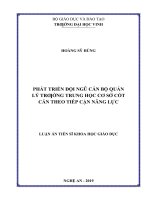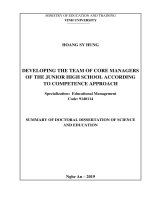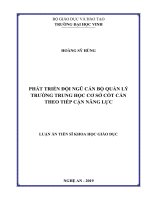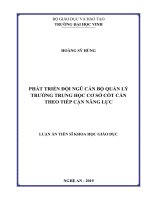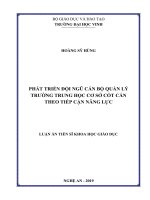(English) Sử dụng xử lý ảnh bằng Opencv ước lượng chiều dài và cân nặng của cá dẹt Hàn Quốc
Bạn đang xem bản rút gọn của tài liệu. Xem và tải ngay bản đầy đủ của tài liệu tại đây (17.47 MB, 19 trang )
Real-time estimation of the
length and body weight of
olive flounder in Indoor
Aquaculture Farms Using
Visual Information
• Nguyen Thi Phuong Hang
• Company: Lucas
CONTENTS
I
Project description
II
Environmental system
III Estimation method
IV Result
V
Application
VI Discussion
Project description
Company partner: Lucas
Motivation:
+ For saving feed and labor, the cost
+ Reducing water pollution during starvation, and improving
feeding activity and feed efficiency shortly after refeeding
+ Achieving compensatory growth of fish
Þ Support the harvest, and optimize the farm management
Purpose:
+ Develop image-based olive flounder length measurement
+ Estimate the body weight based on the length with the
length-weight relationship
II.
Experimental environment
and system
Environmental system
A water tank
(2300 × 1195 ×
1200 mm, 3.3 m3)
A 5×5 cm
grid
2 cameras
Experimental conditions for image data acquisition (top).
And Left-side and right-side phone captures of the training environments (bottom)
Data acquisition
The system includes:
ã A water tank (2300 ì 1195 × 1200 mm, 3.3 m3) with a 5 × 5
cm grid bottom created by the black vertical lines and the
black horizontal lines
•
2 cameras at the top of the tank to capture the image
•
The experiment was performed with 90 olive flounders
•
First, the fish were anesthetized in a solution to losing
consciousness then they were put on an electronic scale and a
measuring board to acquire the accurate weight and length as
the actual length (cm) and weight (g)
Dataset
+
The dataset
(1600x900)
includes
180
images
taken
+ After we get the reference object, we can use the
system to estimate length without the 5x5 grid
Estimation
method
Estimation algorithm
Captured
images
Detect
Contours
Detect extreme
points
Calculate the
distance
between
extreme points
Find the max
distance – pixel
length
Cameras
Training
environment
(reference object)
Lagrange's
interpolation
formula
Length in cm
Lagrange’s interpolating formula
Lagrange’s
interpolating polynomial is an algorithm that can
construct a polynomial that passes through any desired set
of points and is represented as follows:
Here, polynomial of degree passes through points (x1, y1 =
f(x1)),(x2, y2 = f(x2)), …, (xn, yn = f(xn)).
𝑛
𝑘
𝑗
¿𝑘=1
𝑗
𝑘
¿𝑘 ≠ 𝑗
𝑃𝑗 ( 𝑥 ) = 𝑦
∏
𝑥−𝑥
𝑥 −𝑥
Results
Results of Reference environment (reference
object to convert from pixel to real length (cm)
The result of the estimated fish length and
t he table summarize the mean, SD (standard
deviation), R-square, and MSE (Mean squared
error) for evaluating estimated results.
Result of length-weight relationship
Mass estimation models were created using two basic
mathematical relationships: Weight = a(length)b + c
Result of the estimated regression equation between the length and the
body weight of fish (left) and the comparison of estimated data with
surveyed data (right)
Application
Build with Streamlit framework
DEMO VIDEO
DISCUSSION AND CONCLUSION
+ The algorithm proposed with high accuracy (R-squared =
0.994)
+ The length-weight relationship generate to support
estimating the body weight of fish, and the length-weight
model with high accuracy (R-squared = 0.91)
+ The overlapping is a limitation
+ Future work: object detection with a Deep learning model
rotated the bounding box will increase the accuracy of length
THANK YOU
FOR
LISTENING




